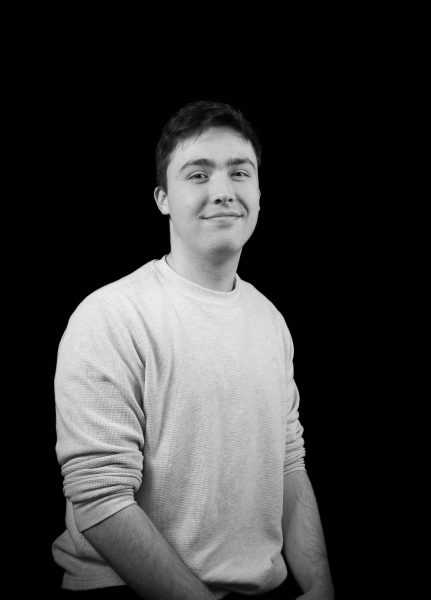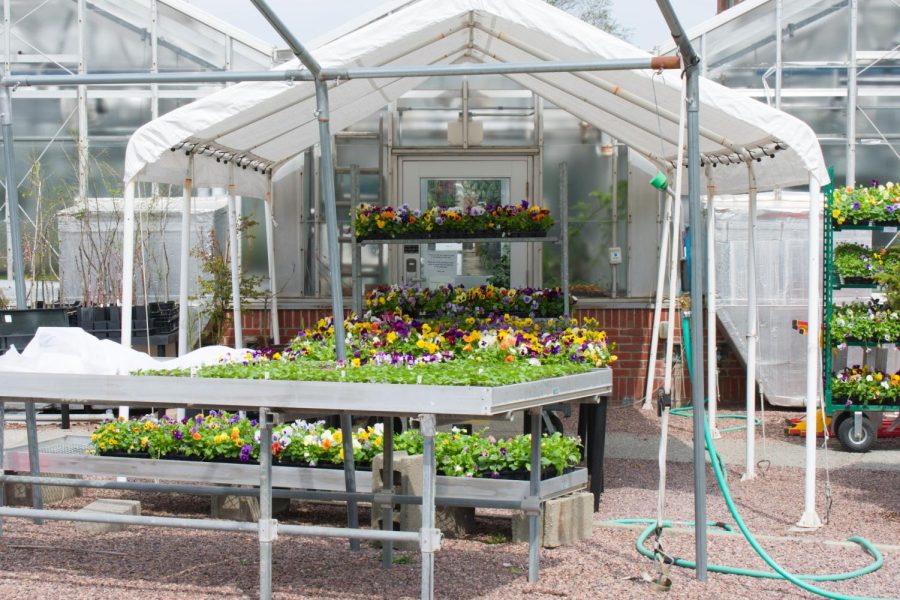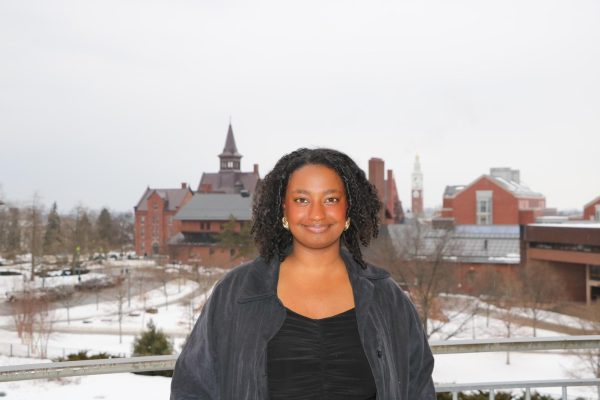UVM sustainability plan sets goal of carbon neutrality by 2030
Plants grown in the UVM Greenhouse on display April 22. The University’s Comprehensive Sustainability Plan aims to reduce carbon emissions and to address climate change.
The University of Vermont set a goal to reach carbon neutrality by 2030, according to an April 18 release on the University’s website.
UVM released a new Comprehensive Sustainability Plan April 18, following a failure to reach its previous goal of carbon neutrality by 2020, according to a May 4, 2022 Cynic Article.
“The University community has a lot of interest in this issue and strongly believes that making a statement of carbon neutrality is important,” said Director of Sustainability Elizabeth Palchak. “We took a hard look at carbon neutrality and what we can do to achieve that goal.”
The goal coincides with similar goals set by the City of Burlington and the State of Vermont, which have set goals of reaching carbon neutrality by 2030 and 2050 respectively, Palchak said.
“It’s an exciting moment for our region that we are all lined up on these critically important goals to reduce carbon emissions over time and to address climate change,” she said. “This plan is coming from the University of Vermont, but it’s really going to take partnerships at all these different levels.”
Carbon neutrality is the practice of countering actions that create carbon emissions with actions that reduce carbon emissions, achieving a net zero carbon output in the atmosphere, according to Yale University’s Office of Sustainability.
The University will take several different approaches in the attempt to reach carbon neutrality and practice sustainability, focusing on increasing the number of electric vehicles in the University’s fleet, increasing composting and recycling and increasing the amount of money spent on Vermont-grown food, according to the CSP.
The CSP includes the implementation of a campus energy plan that will give the University more information on how to best invest, Palchak said.
Palchak is particularly excited about exploring the feasibility of installing geothermal wells across campus as a means of providing renewable energy, she said.
“The drilling of geothermal wells coupled with the campus energy plan, I think, is a really exciting thing for our campus to take a hard look at what it would mean to heat and cool our buildings with geothermal energy,” she said.
According to the plan, the University will also purchase local carbon offsets from the Vermont Land Trust to counter indirect carbon emissions such as travel for commuting or study abroad.
“What feels really important to us is that the carbon offsets we’re purchasing all are sort of made by Vermont,” Palchak said. “There is the opportunity to buy carbon offsets from national companies and we chose to focus our financial investment in Vermont and support Vermont’s forests.”
UVM’s previous plan, the Climate Action Plan, failed to reach its goal of carbon neutrality by 2020 and was criticized for its lack of transparency and lack of student input, according to an April 19, 2021 Cynic article.
Palchak said making the Comprehensive Sustainability Plan more transparent and inclusive of student input was a priority for her in the process of creating the plan.
“Members of the Committee of the Environment from SGA reached out to me within a month of me being hired and said, ‘what are you going to do to work on carbon neutrality? How can we help you and can you please keep us informed?’” she said.
The Office of Sustainability will review the plan every five years in order to ensure the University is on track to reach its 2030 goal, and students will play a large part in that process, Palchak said.
“We’ll take a hard look at how far we’ve gotten and look at ‘should we be pushing further? Where do we need to adapt to get to the carbon neutrality goal?’” she said. “Students will be involved in all of that. We’ll create a group that will be tracking and reporting our progress.”
Palchak also said incorporating student input into the CSP has been an exciting and positive experience.
“Student questions make the work better,” she said. “I feel really good about the relationship that we have with the students and their input. This has been really important.”
Palchak said that students were involved throughout the development of the plan, notably with the rollout of a special campus sustainability survey concerning issues that students considered important and wanted the plan to prioritize.
“We had them on the workgroup, I was meeting with SGA regularly over the last year,” Palchak said. “I presented to SGA last week because I wanted their input before we rolled out the full plan, and moving forward that will be the case.”
The CSP Work Group included two undergraduate students and two graduate students, according to the CSP. The Advisory Team included one undergraduate student.
Palchak said one of the resounding messages she has heard from students, faculty and staff is the importance of continued leadership and prioritization of sustainability issues by the University.
“It’s important that UVM continue to invest and set goals to maintain our reputation as a sustainability leader,” she said. “We have a history of showing leadership on sustainability issues, but it is crucial that we continue to act and continue to prioritize this at the University of Vermont.”
The Comprehensive Sustainability Plan was originally slated to be published in August 2022, according to a release by the Office of Sustainability. Palchak said the delay stemmed from the University’s choice to develop the plan internally rather than with an external firm.
“It took a lot of time to get it right,” Palchak said. “There’s no reason aside from the fact that it’s just been a massive amount of work, and it took a long time to kind of do the analysis that we needed to feel confident in the final goals and strategies that we’ve presented.”
Palchak said she hopes the plan sends a message about the seriousness with which the University, as well as the state, regards the issue of climate change.
“We have, I think, something really important to say in this state, in this corner of the state, about the importance of climate change to the people who live here,” she said.
Jon Erickson, professor of sustainability science and policy, said he is in support of the plan and believes it to be emblematic of what the University has to offer.
“We have a comprehensive plan that really has the full suite of what our University can do on climate change, on sustainability, on food waste,” he said. “It’s good news. It incorporates our research, our education and our operations.”
Erickson said he supports the measures the plan entails, believing it to be truly comprehensive about the goals it sets out to achieve.
“I’m thrilled to see a carbon goal,” he said. “The plan commits the University to be carbon neutral by 2030 […] and an explanation of our various dimensions of carbon emissions and how we’ll use a balance of in-house activities as well as carbon offsets, as well as reduction of our overall energy use.”
Erickson said he thinks the goal of carbon neutrality by 2030 is realistic because of UVM’s carbon commitment with a firm called Second Nature, which acts as a caretaker of commitments by universities and colleges across the country, many of whom have already reached their carbon goals.
“There’s a handful of universities who have already met their carbon neutral pledge,” he said. “Most universities have pledged in the 2030 to 2035-2040 range. This will really put us in a good position for the next wave of universities that will be carbon neutral.”
Erickson said UVM’s commitment to carbon neutrality makes sense as a university that emphasizes sustainability and climate change research.
“As an education institution that’s teaching about climate change [and] doing research on climate change, it makes perfect sense that we would also do something about climate change,” he said.
Erickson said the plan is a significant achievement and the first of its kind during his tenure at the University.
“I’ve been at the University of Vermont for over 20 years, and I’ve seen steady progress towards sustainability,” he said. “This is the first time we have an all-hands-on-deck plan, which is a huge step in the right direction.”
Erickson said the comprehensive plan takes the University in a direction he thinks society needs to take as well, which is to get everyone involved in the effort to curb climate change.
“Sustainability can’t be something sequestered away in a department or school or a major,” he said. “Sustainability should be woven through the very fabric of our University, and that’s what this comprehensive plan sets out to do.”
Erickson said he believes revising the plan every five years is a smart idea.
“A comprehensive sustainability program should be a living document,” he said. “It should be something that we revisit constantly, should be something that we use as a gauge to measure our teaching, our research, our outreach or our facilities management against.”
Erickson said the only thing missing now is involvement and support from the community.
“This is the time to connect climate action to our coursework, to connect climate change to our facilities management, to connect climate change to everything we do,” he said. “The University is unique in terms of a sector of the economy that emits greenhouse gas emissions because we can learn from our practice. We can apply new ideas right here in our own backyard.”

(he/him)
Noah Diedrich is a senior history and english double major from Arlington, Vermont. He became a Cynic news reporter as a sophomore. When not...









